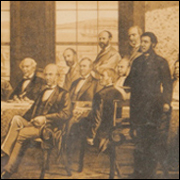The birth of a nation, 30 years in the making
October 28, 2014
When Confederation was proclaimed on July 1, 1867, it marked an end as well as a beginning. The birth of the Dominion of Canada was also the conclusion of a tumultuous, 30-year journey of violence, negotiation and compromise that ultimately allowed Canada’s divided populations and regions to unite.
The exhibition 1867 – Rebellion and Confederation, coming soon to the Canadian Museum of History, takes us back to the series of historical milestones that sowed the seeds of Canadian democracy and self-government. The exhibition highlights a chain of events that had a domino effect leading to dominion. The first was in 1837, when Queen Victoria ascended the throne, and democratic and anti-colonial movements were shaking Europe and the Americas.
The winds of change were blowing through the colonies, and major transformations were on the horizon. These great political, social, economic and cultural upheavals — and the manner in which they came about — are reflected today in our Canadian identity, our values and our institutions.
Three decades before Confederation, the people of what is now Canada were increasing in number and diversity, and their values often clashed. Anglophones and Francophones, Catholics and Protestants, reformers and loyalists struggled to coexist, sometimes fighting physically and at other times cooperating to attain common goals.
The exhibition takes visitors through the armed revolts and brutal repression that shook the colonies, the unlikely alliance of Francophone and Anglophone reformers, the violent rioting by those seeking to maintain the status quo, and the slow process of negotiation that led to the British North America Act.
From Louis-Joseph Papineau’s and William Lyon Mackenzie’s failed rebellions in 1837–1838 to Britain’s decision to unite Lower and Upper Canada as the Province of Canada in 1840, from Lord Elgin establishing responsible government in 1848 to the burning of Parliament by Loyalists rioters in 1849, this exhibition highlights key personalities and pivotal events that led to Confederation.
The upcoming exhibition also examines the Charlottetown, Québec City and London Conferences, the Constitutional Debates and other key meetings from 1864 to 1867, when the Fathers of Confederation (including John A. Macdonald, George-Étienne Cartier and Charles Tupper) argued for self-government and drafted the British North America Act passed on July 1, 1867.
The exhibition will feature about 200 historical artifacts from the Museum’s own collections and from other institutions in Canada, Britain and the United States.
While most Canadians are aware of Confederation, few are familiar with the struggles, cooperation and trade-offs that made it possible, or with the mixed reactions at the time to the Dominion of Canada. The exhibition tells the whole story in detail and adds valuable political, social and economic context to help us understand how this historical legacy influences us today.
1867 – Rebellion and Confederation will be presented from November 27, 2014 to January 4, 2016 at the Canadian Museum of History.
National Presenting Sponsor
